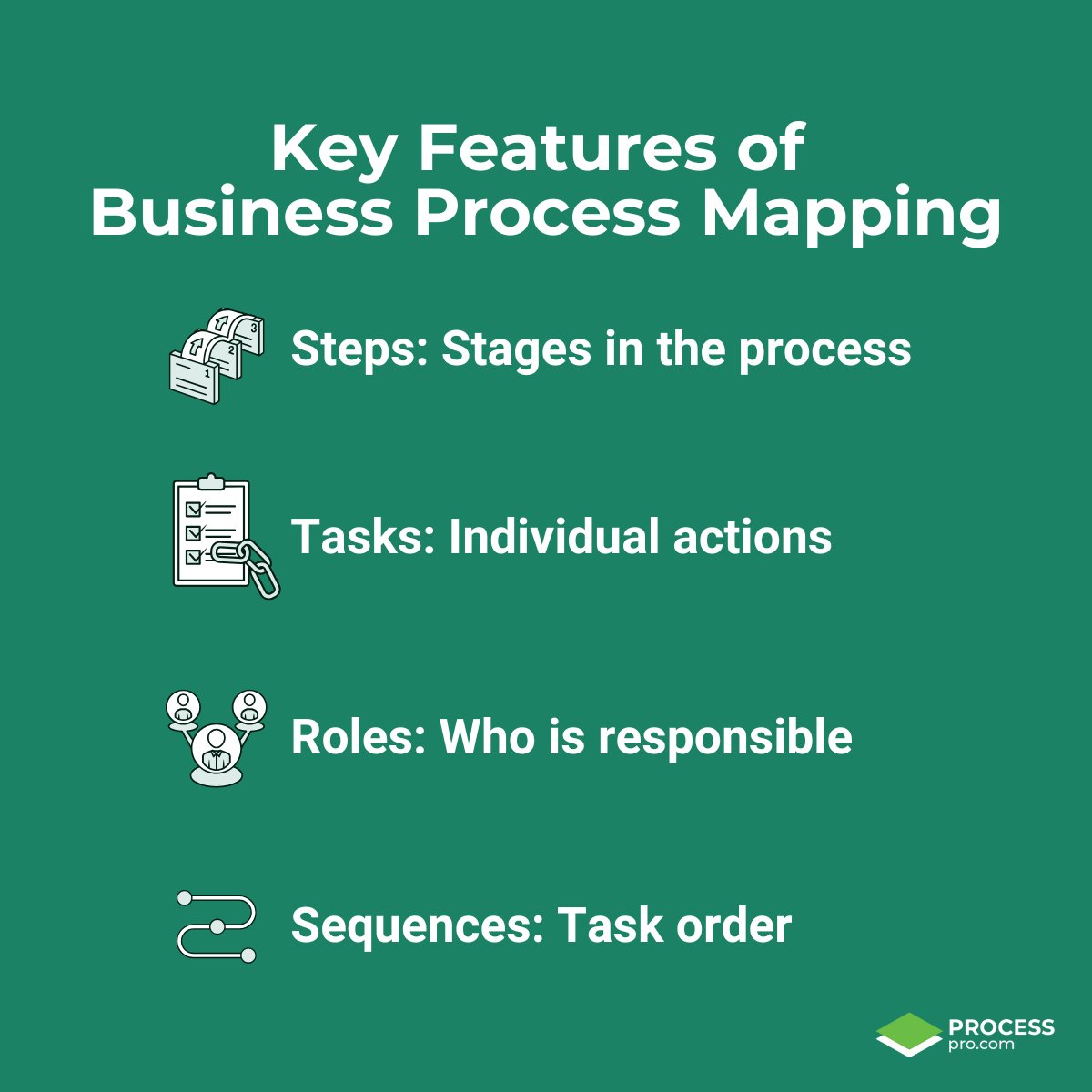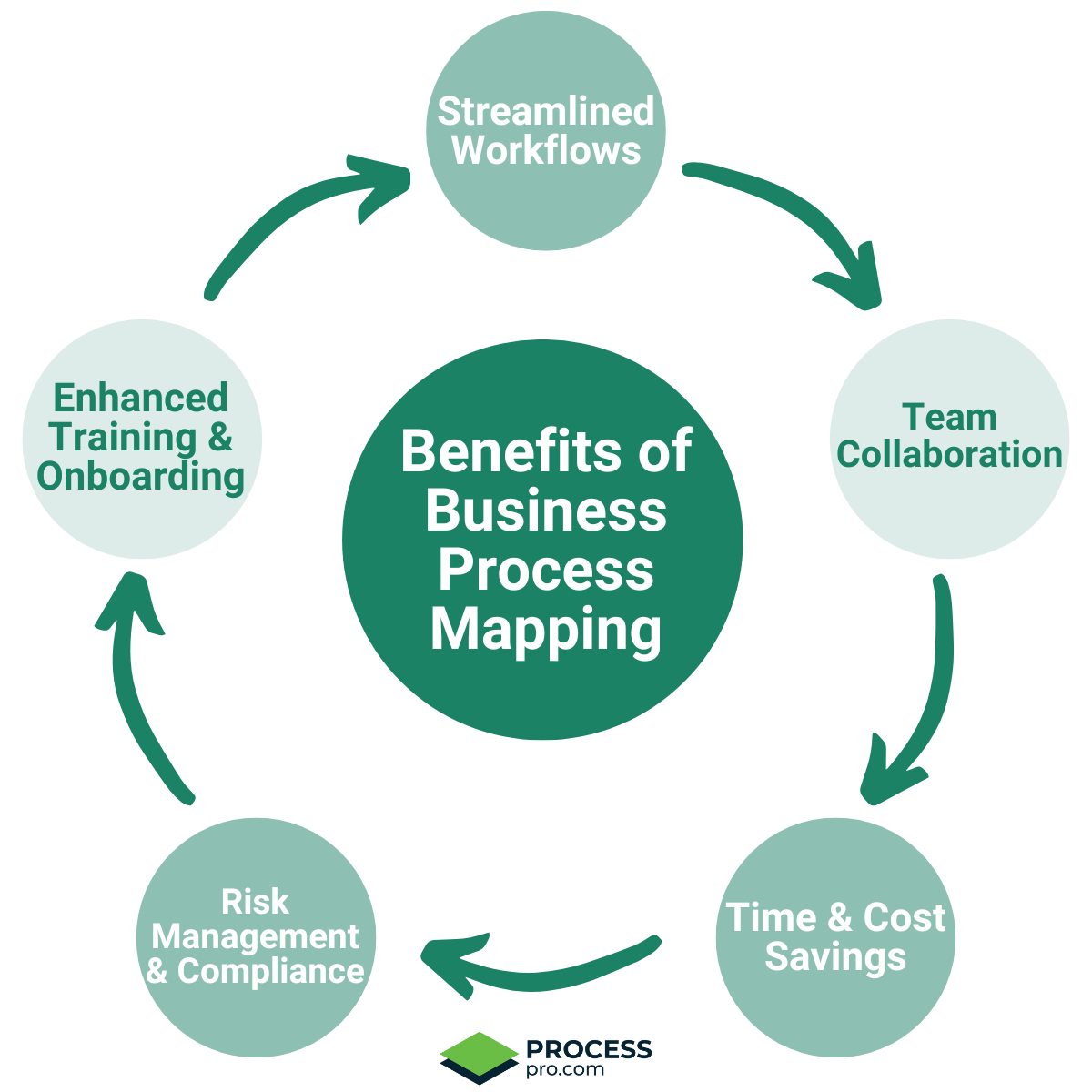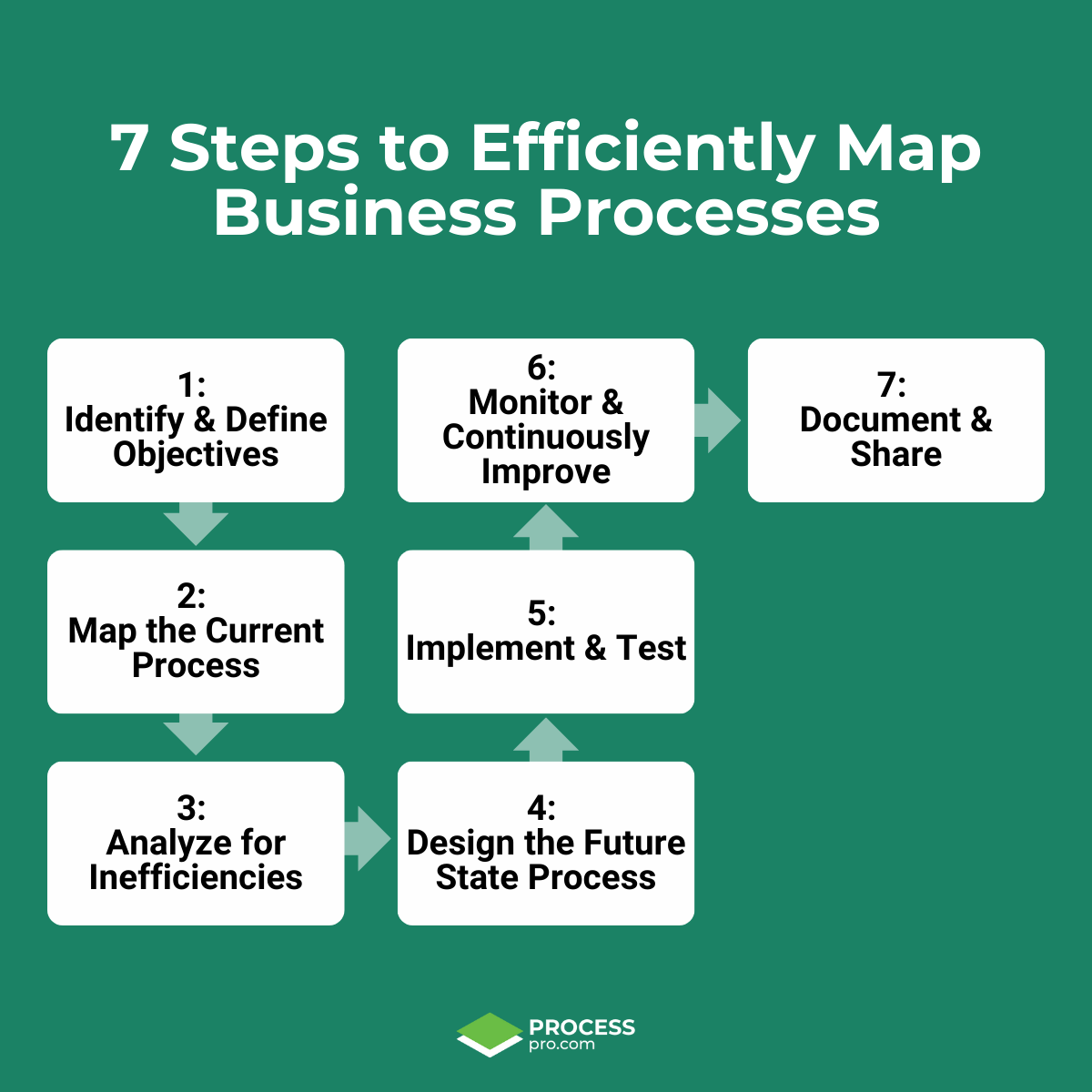Business process mapping: A 7-step guide to improve workflow
Posted by Angela Alberts on June 17, 2024
Business process mapping is a powerful technique that allows organizations to visualize, analyze, and improve their workflows. If you’ve been wondering how to map a business process effectively, this blog post will guide you through the key steps to create a process map that not only streamlines operations but also helps identify opportunities for growth and innovation. Studies show that businesses implementing process mapping improve productivity by 30%-50%.
In this guide, we’ll cover:
Let’s dive in and optimize your business processes!
1. What is business process mapping?
Business process mapping is the practice of visually documenting the steps in a business workflow. It helps organizations:
- Understand and optimize processes
- Identify inefficiencies
- Improve collaboration between teams
- Ensure compliance with industry standards

4 Key features of effective business process mapping
When creating a business process map, there are four key features to keep in mind:
Steps (Stages in the process)
Break your workflow into major stages or milestones. Each step represents a significant phase in your overall process.Tasks (Individual actions)
Under each step, list the specific tasks or activities that need to be completed. These tasks move the process forward and should be as clear and actionable as possible.Roles (Who is responsible)
Identify the individuals, teams, or departments accountable for each task or step. Clearly assigning responsibility prevents confusion and ensures tasks are completed efficiently.Sequences (Task order)
Establish the logical order of tasks to maintain a smooth workflow. Understanding how tasks flow from one to the next helps pinpoint potential bottlenecks or redundancies.
By focusing on these features—steps, tasks, roles, and sequences—you’ll create a clearer, more effective process map that can be easily understood and improved over time.
Example:
A customer onboarding process might include steps like inquiry, needs assessment, proposal, contract, and training, with specific tasks assigned to roles in a logical sequence to ensure a smooth workflow.
2. Why business process mapping improves workflow efficiency
Business process mapping is not just about diagrams—it’s about making businesses more efficient and scalable.
In addition to improving efficiency, the business process mapping benefits include streamlined operations, enhanced team collaboration, and significant time and cost savings.

5 Benefits of business process mapping
- Streamlined operations – Reduce redundant tasks and optimize workflows
- Better team collaboration – Improves clarity across departments
- Time and cost savings – Eliminates waste and speeds up processes
- Risk management and compliance – Ensures adherence to industry regulations
- Easier employee training and onboarding – Provides new hires with a clear roadmap
Example:
A manufacturing company implementing business process mapping reduced production delays by 40% by identifying inefficiencies in their supply chain workflow.
3. Business process mapping examples
Example 1: Retail order processing
Before Mapping: A retail company struggled with delayed order processing due to miscommunication between the warehouse and sales team.
After Mapping: By creating a process flowchart, they identified unnecessary approval steps and automated order confirmations, reducing order processing time by 30%.
Example 2: HR onboarding process
Before Mapping: New employees took weeks to get fully onboarded due to scattered documentation and unclear workflows.
After Mapping: By implementing HR process mapping, the department streamlined its procedures, cutting onboarding time in half—from 10 days to just 5 days.

4. The 7 Steps to efficiently map business processes
Step 1: Identify and define objectives
Start by clarifying what you want to achieve with your process map. Use the SMART criteria—specific, measurable, achievable, relevant, and time-bound—to define clear goals. For example, you might aim to reduce order processing time by 20% within three months.
Define clear goals for your process mapping project using the SMART criteria:
- Specific – Reduce customer support response time
- Measurable – Decrease response time by 20%
- Achievable – Implement automated ticket routing
- Relevant – Improve customer experience
- Time-bound – Achieve results within 3 months
Involve key stakeholders early to gather insights and ensure alignment. Clear objectives provide a focused direction for your mapping efforts.
Step 2: Map the current process
Create a visual representation of your current workflow using tools like flowcharts or swimlane diagrams. Include every step, decision point, input, and output.
- Use flowcharts or diagrams to visualize your existing workflows. Include:
- Key stakeholders (employees responsible for each step)
- Decision points (approval requirements, delays)
- Bottlenecks (areas causing inefficiency)
- Tip: Business process mapping tools like ProcessPro make visualizing your current workflows easier.
Engage team members who work directly with the process. Their insights can help you identify gaps or undocumented steps. This baseline map will be your foundation for analysis and improvement.
Step 3: Identify inefficiencies
Look closely at your current process map to identify bottlenecks, redundancies, or delays. Techniques like value stream mapping can help distinguish value-added steps from non-value-added ones.
Analyze your process map and look for:
- Redundant steps – Tasks that add no value
- Bottlenecks – Steps that slow down workflow
- High costs – Expensive manual processes
- Example: A finance department mapping its invoice approval process found that requiring multiple manager approvals caused unnecessary delays. Solution? They automated approvals under a specific amount.
Ask your team for feedback. Their day-to-day experience often reveals inefficiencies not obvious on the surface. Prioritize areas that have the greatest impact on performance.
Step 4: Design the future process
Using your analysis, create an optimized process map. Remove unnecessary steps, streamline decision points, and consider automating repetitive tasks.
Create an optimized version of your process by:
- Eliminating unnecessary steps
- Automating repetitive tasks
- Streamlining communication between teams
- Pro Tip: Use workflow automation tools like ProcessPro.
Collaboration is key. Involve team members in brainstorming solutions to foster buy-in and ensure the new process is practical.
Step 5: Implement and test the new process
Roll out the new process on a small scale to test its effectiveness. Use performance metrics, like cycle time or error rates, to evaluate its impact. Provide clear communication and training to ensure everyone understands the changes.
Start with a pilot test before rolling out changes company-wide.
- Choose a small department or group to test changes
- Track key performance indicators (KPIs)
- Gather feedback and make improvements
- Example: A marketing team tested an automated campaign approval process and reduced campaign launch times by 50%.
Step 6: Monitor and improve continuously
After implementation, monitor the new process regularly. Use tools like Lean or Six Sigma to guide improvements and adapt to changing needs. Regular feedback sessions ensure your process stays relevant and effective.
Process mapping is not a one-time task—businesses must refine workflows regularly.
- Use real-time analytics to track performance
- Gather feedback from employees and customers
- Adjust based on new technology or business needs
- Best Practice: Schedule quarterly process reviews.
Step 7: Document and share the process
Document the optimized process in a clear, accessible format. Use visuals to make it easy for team members to understand and follow. Share the process through a centralized system to ensure consistency and streamline onboarding for new employees.
A well-documented process:
- Helps new employees understand workflows
- Ensures consistency across teams
- Improves training and compliance
- Use ProcessPro, a centralized system to store and update process maps.
Watch this video to see how easy it is to build a process using ProcessPro’s business process mapping tool.
5. FAQs about business process mapping
Q1: What is the first step in business process mapping?
The first step is to identify and define objectives. This means clarifying what you want to achieve with your process map—such as reducing order processing time or cutting costs—by setting specific, measurable, achievable, relevant, and time-bound (SMART) goals. Clear objectives guide your mapping efforts and serve as the foundation for identifying inefficiencies and opportunities for improvement.
Q2: How often should I update my business process maps?
You should review every 6-12 months or whenever there is a significant workflow change.
Q3: What are the best tools for business process mapping?
There are many business process mapping tools available to suit different needs. Some popular options include:
- Diagramming Software: Tools like Microsoft Visio are great for creating flowcharts and swimlane diagrams which can be integrated into the ProcessPro platform.
- Specialized Platforms: Business process mapping tools like ProcessPro offer tailored features for mapping complex workflows and integrating process improvements.
Each of these tools can help you visualize your workflows, identify inefficiencies, and drive continuous improvement.
Q4: How do I improve an existing business process?
Begin by mapping your current process to visualize every step and identify bottlenecks. Next, pinpoint inefficiencies such as redundant tasks and delays, then redesign the workflow to streamline operations. Finally, test the updated process on a small scale, gather feedback, and monitor performance to ensure continuous improvement.
Q5: How do I know if my business process map is effective?
A good process map should:
- Be easy to understand
- Clearly define each step
- Show how teams interact
- Help solve an actual business problem
Q6: Can process mapping help with automation?
Yes! Process mapping helps identify tasks that can be automated (e.g., invoice approvals, email responses, HR onboarding).
Ready to simplify and streamline your business processes?
Whether you’re just getting started or looking to take your process mapping to the next level, the right tools make all the difference. ProcessPro helps you visually map, optimize, and manage your processes—all in one intuitive platform. With built-in AI, role-based ownership, version control, and real-time alerts, it’s never been easier to drive efficiency and stay compliant.
Book a demo today and see how ProcessPro can help you turn better processes into better business outcomes.

Angela Alberts
My name is Angela and I am the QA for ProcessPro. I work alongside our development team to identify, develop and drive the testing activities to ensure the delivery of a high-quality product. I also work closely with the support team to improve documentation and help material. Our collaboration ensures that customers receive a quality, user-friendly product to help them improve their organizations’ productivity.
Share this article

